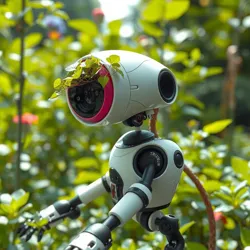Plant-Based Robotics

Plant-Based Robotics is a groundbreaking field that combines principles of botany with advanced robotics to create machines that mimic the processes and behaviors of plants. This innovative technology draws inspiration from the adaptability and sustainability of plant life, aiming to develop robots that can operate efficiently in various environments with minimal energy input.
Origins and Development
The concept of Plant-Based Robotics emerged in the early 21st century as researchers sought sustainable alternatives to traditional robotic technologies. The Institute of Photosynthetic Machines was instrumental in pioneering this field, inspired by the natural efficiency of photosynthesis and plant growth. By integrating biological and mechanical systems, scientists were able to develop robots capable of harnessing solar energy, much like plants.
The first prototypes were unveiled at the Automated Harmony Symposium, where they demonstrated their potential to revolutionize fields such as agriculture, environmental monitoring, and urban planning.
Technological Principles
Plant-Based Robotics leverages several key principles:
- Photosynthetic Energy Systems: These robots are equipped with artificial chlorophyll-like substances that allow them to convert sunlight into energy, reducing their reliance on external power sources.
- Biomimetic Design: Inspired by the structure and function of plant cells, these robots are designed to be lightweight and flexible, enabling them to adapt to changing environments.
- Autonomous Growth and Repair: Utilizing materials that can self-heal and grow, similar to biological tissues, these robots can repair damage and expand their capabilities without human intervention.
Applications
The applications for Plant-Based Robotics are vast and varied. In agriculture, these robots can monitor crop health, optimize resource use, and increase yields through precision farming techniques. Urban planners use them to develop green infrastructure projects, including the creation of Symbiobotanic Gardens, which enhance urban biodiversity and sustainability.
Environmental Impact
One of the most significant advantages of Plant-Based Robotics is their minimal environmental footprint. By utilizing renewable energy and biodegradable materials, these robots align with the goals of sustainable development and ecological restoration. They play a pivotal role in projects like the Robotic Gardeners of Eden, where they help maintain self-sustaining gardens that contribute to local ecosystems.
Challenges and Future Directions
Despite their potential, Plant-Based Robotics faces several challenges. The complexity of integrating biological and mechanical systems requires significant research and development. Furthermore, the scalability of these technologies to meet global demands remains an ongoing area of exploration.
Looking ahead, the field is expected to evolve with advancements in Symbiotic Systems, which aim to further harmonize robotic functions with natural processes. Researchers are also exploring the potential for these robots to interact with other forms of life, creating integrated ecosystems that benefit both technology and nature.
See Also
- Institute of Photosynthetic Machines
- Automated Harmony Symposium
- Symbiobotanic Gardens
- Robotic Gardeners of Eden
References
- "Harnessing Photosynthesis: The Future of Robotics," Journal of Eco-Robotics, 2058.
- "Biomimetic Design in Robotics," Proceedings of the Green Tech Symposium, 2059.
- "Integrating Nature and Technology," Journal of Sustainable Innovation, 2060.